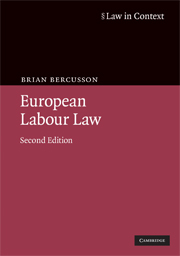Book contents
- Frontmatter
- Contents
- Preface
- Section I Labour law and Europe
- Section II The structure of European labour law
- 8 The institutional architecture of the European social model
- 9 A framework of principles and fundamental rights for European collective labour law
- 10 A framework of principles and fundamental rights for European individual employment law
- 11 The European Court of Justice, the EU Charter of Fundamental Rights and the European social model
- 12 General principles of enforcement of European labour law
- 13 Administrative enforcement of European labour law
- 14 Implementation and enforcement of European labour law and employment policy through the social partners at national and EU levels
- 15 Individual judicial enforcement of European labour law
- 16 Euro-litigation: collective judicial enforcement of European labour law
- 17 The European social dialogue: from dynamism to benign neglect 1993–2008
- 18 External and internal scrutiny of the democratic legitimacy of the European social dialogue
- 19 Threats and challenges to and the future of the European social dialogue
- Section III The futures of European labour law
- Index
15 - Individual judicial enforcement of European labour law
from Section II - The structure of European labour law
Published online by Cambridge University Press: 05 June 2012
- Frontmatter
- Contents
- Preface
- Section I Labour law and Europe
- Section II The structure of European labour law
- 8 The institutional architecture of the European social model
- 9 A framework of principles and fundamental rights for European collective labour law
- 10 A framework of principles and fundamental rights for European individual employment law
- 11 The European Court of Justice, the EU Charter of Fundamental Rights and the European social model
- 12 General principles of enforcement of European labour law
- 13 Administrative enforcement of European labour law
- 14 Implementation and enforcement of European labour law and employment policy through the social partners at national and EU levels
- 15 Individual judicial enforcement of European labour law
- 16 Euro-litigation: collective judicial enforcement of European labour law
- 17 The European social dialogue: from dynamism to benign neglect 1993–2008
- 18 External and internal scrutiny of the democratic legitimacy of the European social dialogue
- 19 Threats and challenges to and the future of the European social dialogue
- Section III The futures of European labour law
- Index
Summary
Introduction
The development of a model whereby EC labour law could be enforced by individuals seeking redress before national tribunals and courts – a judicial liability model – could have followed one of at least two tracks. Enforcement of EC law could have been left entirely to national law. The national system of remedies, procedures and sanctions could have been exploited to maximise the enforcement of substantive EU labour law rights. Building on the foundation of these purely national remedies, procedures and sanctions, an effort might be made to develop certain minimum standards of enforcement.
Alternatively, the attempt might be made to create an entirely original form of judicial liability system, developing a new EU law on remedies, procedures and sanctions, to which national law must conform. This solution would require the EU institutions to prescribe a system of harmonised rules on enforcement covering remedies, procedures and sanctions. The legislative organs of the EU have refused to do so; there is lacking a consensus among Member States that this is either necessary or desirable.
The consequence of the failure to develop a harmonised system of enforcement of EU labour law is, however, that there may be considerable diversity among Member States with regard to the efficacy of enforcement of generally applicable EU labour law norms. Those Member States with less efficacious remedies, more procedural restrictions, and weaker sanctions may better be able to avoid compliance with EU labour law by effectively reducing the likelihood of judicial redress for those benefiting from it, or the likelihood of liability of those subject to it.
- Type
- Chapter
- Information
- European Labour Law , pp. 467 - 495Publisher: Cambridge University PressPrint publication year: 2009

